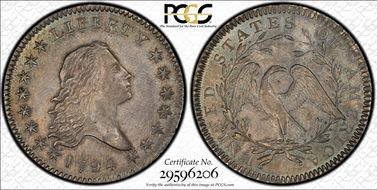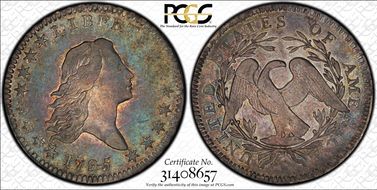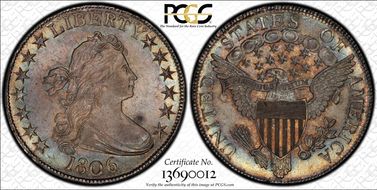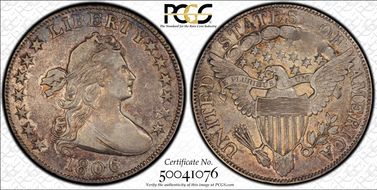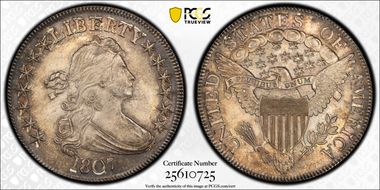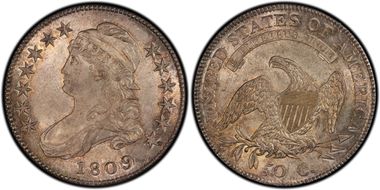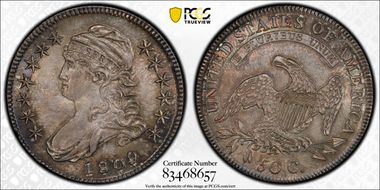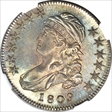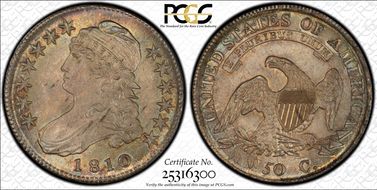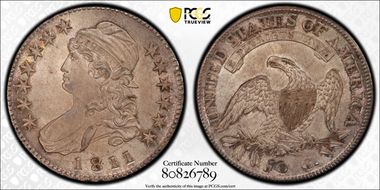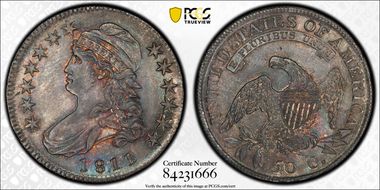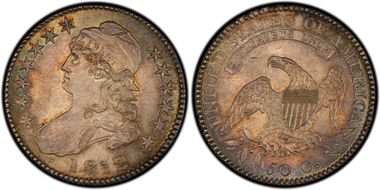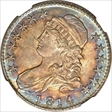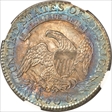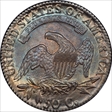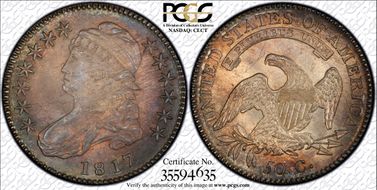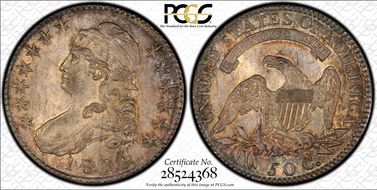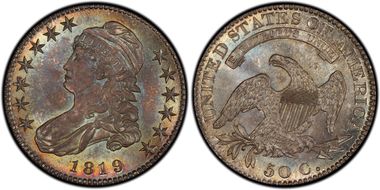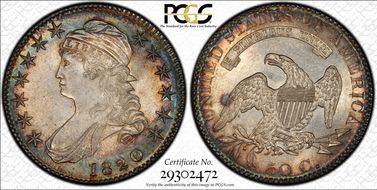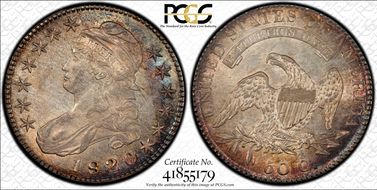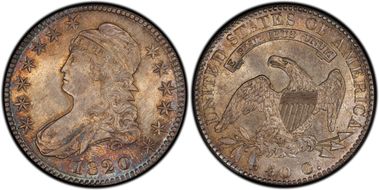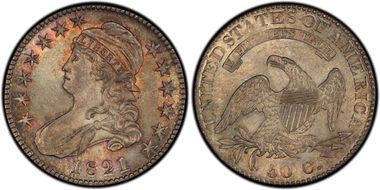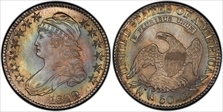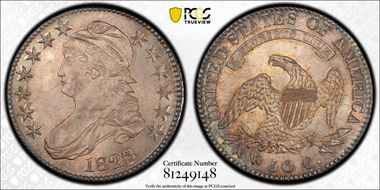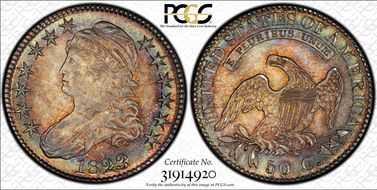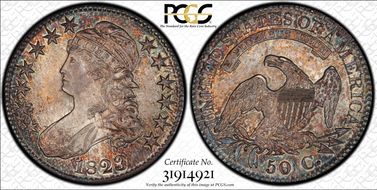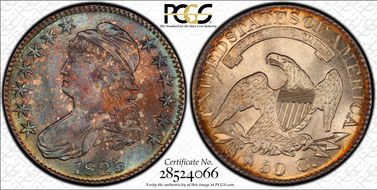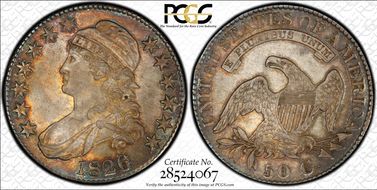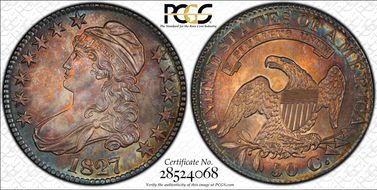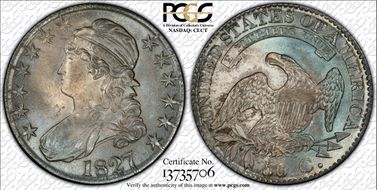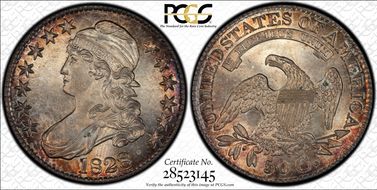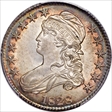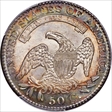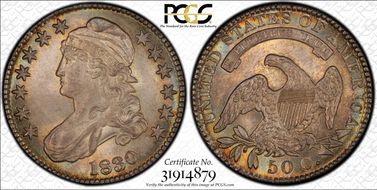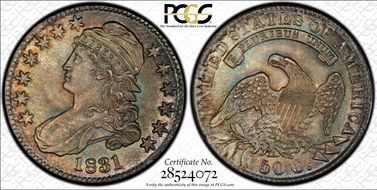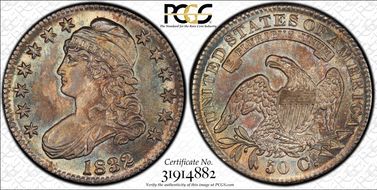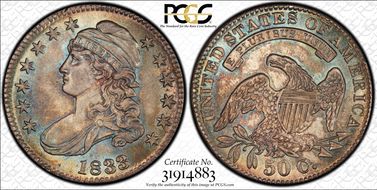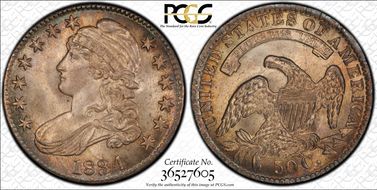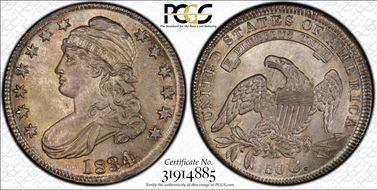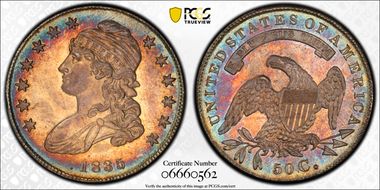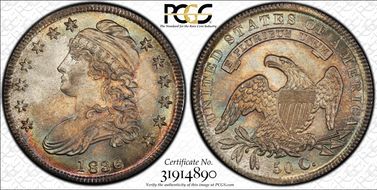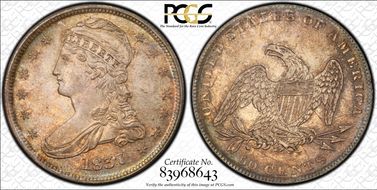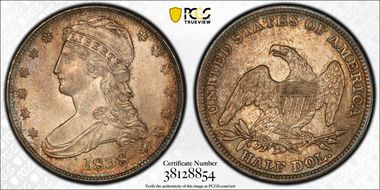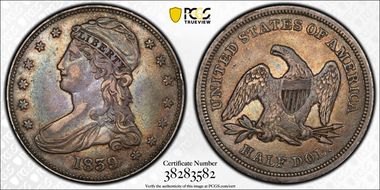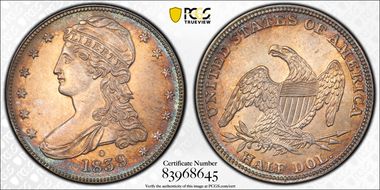The Link Early American Silver Collection of Flowing Hair and Draped Bust Half Dollars 的钱币相册
O.129a S/D. Tied Finest Known. . Eliasberg. Pogue. "Provenance: Harlan P. Smith Collection; Henry and S. Hudson Chapman’s sale of the Harlan P. Smith Collection, May 1906, lot 568; John M. Clapp Collection; John H. Clapp, by descent, 1906; John H. Clapp Collection; Clapp Estate; Louis E. Eliasberg, Sr. Collection, via Stack’s, 1942; Richard A. Eliasberg, by descent, 1976; Bowers and Merena’s sale of the Louis E. Eliasberg, Sr. Collection, April 1997, lot 1671." Obtained from Stacks Bowers Auction of the D. Brent Pogue Collection on May 19, 2015, Lot 1097.
O.112 R4. Gardner. Very tough and difficult variety to find in high grade. Second finest known for the die marriage. "Laborers at the Philadelphia Mint adjusted the planchet of this piece before it was struck, and the coinage operation failed to obliterated those crisscross file marks. Both sides show nearly full luster under delicate champagne toning. A few post-strike blemishes are minor," per cataloger. Crossed from NGC AU58 to PCGS AU55 on February 23, 2015. Heritage Auction #1214 of the Eugene Gardner Collection on October 27, 2014, Lot 98458.
O-126a R4+. Small Head. Per cataloger, "Ex: House of Davis McKinney. The diagonal die crack through the E in UNITED is diagnostic for the scarce O-126a. The Small Head subtype is limited to three die marriages, O-126 through O-128, and is a challenging Guide Book acquisition. This golden-brown and apple-green Choice VF half dollar is remarkably unabraded and offers exceptional eye appeal for its designated grade. The eagle's plumage retains hints of mint luster. The central reverse exhibits high-point adjustment marks, as present on the planchet prior to the strike. O-126a Population: 2 in 35, 1 finer (10/15)." Obtained from Heritage Galleries ANA Auction #1231 on January 6, 2015, Lot 3964.
O.113a R4. Eliasberg. Finest Known. Lovely satin finish with strong cartwheel luster of silvery and shimmering surfaces. Private treaty with Legend Numismatics on August 11, 2015.
Eliasberg. O.101 R5+. "Small Eagle. O-101. Rarity-5. 15 Stars. MS-63 (PCGS). OGH. The Eliasberg Choice Mint State 1796 15 Stars Half Dollar. Second Finest Regular Strike Known. Described as Prooflike in our sale of the Eliasberg Collection, both sides of this piece do reveal modest reflectivity in the fields as the surfaces rotate under a light. Otherwise satiny in texture, handsome toning in silver-lilac and olive-russet speaks volumes about this coin's originality. The strike is as close to full as one could realistically expect to see in a Small Eagle Draped Bust half dollar, and there is not so much as a single outwardly distracting abrasion on either side. For provenance confirmation the obverse has faint adjustment marks in Liberty's hair moving from upper left down to lower right, crossing her temple, and the reverse has a small nick below the right (facing) wing, as noted in the recent reference work by Jon P. Amato, Ph.D. titled The Draped Bust Half Dollars of 1796 - 1797 with this specific coin noted on page 47. Two Specimens are noted from these dies, one is the Knoxville specimen, the other is from the Mougey-Granberg-Allenburger-Judd-Walter specimen. The original mintage of this issue is believed to be around 400-600 pieces, with a similar number struck of the sixteen star obverse variety for the recorded total of 934 pieces. Therefore, this issue is one of the rarest regular issue silver coins of the entire mints silver production. Survival rates are low from this early period, and all the known examples have been tracked through auction appearances by Dr. Amato and are carefully researched and presented in his published work. It would be difficult to imagine a much finer example than the present coin, and considering the expanding pursuit of these types of rarities and the classic American coins, we suspect the attention to continue to be focused on these well known rarities for years to come. Here is an opportunity to put away one of the great blue chip coins of American numismatics, and a coin that will instantly be recognized by any knowledgeable collector when presented. Pedigree: Ex: Benjamin H. Collins, January 1896; J.M. Clapp; John H. Clapp; Clapp estate, 1942; Louis E. Eliasberg, Sr.; our sale of the Louis E. Eliasberg, Sr. Collection, April 1997, lot 1673; Heritage's Denver, CO Signature & Platinum Night Auction of August 2006, lot 5222; our Orlando Sale of January 2009, lot 400, unsold; our Treasures from the S.S. New York sale, July 2009, lot 523," per Stack's cataloger. Stacks Bowers Auction The February 2014 Americana Sale - Session 3 on 2/6/2014, Lot 2063.
Eliasberg. O.101 R5+. "Small Eagle. O-101. Rarity-5. 15 Stars. MS-63 (PCGS). OGH. The Eliasberg Choice Mint State 1796 15 Stars Half Dollar. Second Finest Regular Strike Known. Described as Prooflike in our sale of the Eliasberg Collection, both sides of this piece do reveal modest reflectivity in the fields as the surfaces rotate under a light. Otherwise satiny in texture, handsome toning in silver-lilac and olive-russet speaks volumes about this coin's originality. The strike is as close to full as one could realistically expect to see in a Small Eagle Draped Bust half dollar, and there is not so much as a single outwardly distracting abrasion on either side. For provenance confirmation the obverse has faint adjustment marks in Liberty's hair moving from upper left down to lower right, crossing her temple, and the reverse has a small nick below the right (facing) wing, as noted in the recent reference work by Jon P. Amato, Ph.D. titled The Draped Bust Half Dollars of 1796 - 1797 with this specific coin noted on page 47. Two Specimens are noted from these dies, one is the Knoxville specimen, the other is from the Mougey-Granberg-Allenburger-Judd-Walter specimen. The original mintage of this issue is believed to be around 400-600 pieces, with a similar number struck of the sixteen star obverse variety for the recorded total of 934 pieces. Therefore, this issue is one of the rarest regular issue silver coins of the entire mints silver production. Survival rates are low from this early period, and all the known examples have been tracked through auction appearances by Dr. Amato and are carefully researched and presented in his published work. It would be difficult to imagine a much finer example than the present coin, and considering the expanding pursuit of these types of rarities and the classic American coins, we suspect the attention to continue to be focused on these well known rarities for years to come. Here is an opportunity to put away one of the great blue chip coins of American numismatics, and a coin that will instantly be recognized by any knowledgeable collector when presented. Pedigree: Ex: Benjamin H. Collins, January 1896; J.M. Clapp; John H. Clapp; Clapp estate, 1942; Louis E. Eliasberg, Sr.; our sale of the Louis E. Eliasberg, Sr. Collection, April 1997, lot 1673; Heritage's Denver, CO Signature & Platinum Night Auction of August 2006, lot 5222; our Orlando Sale of January 2009, lot 400, unsold; our Treasures from the S.S. New York sale, July 2009, lot 523," per Stack's cataloger. Stacks Bowers Auction The February 2014 Americana Sale - Session 3 on 2/6/2014, Lot 2063.
O.102 R5+. Ex: Reed Hawn and Gene Gardner. Second finest known at PCGS. Per cataloger, "1796 16 Stars Half Dollar, O-102, Boldly Struck MS64. Second-Finest Example at PCGS. A Choice Type Coin. 16 Stars, O-102, High R.5, MS64 PCGS. Amato-201. Whispers of soft tan patina visit the central areas of this lustrous, silver-gray near-Gem, being somewhat more extensive and deeper in hue on the reverse. Bold detail appears on the design elements, including the strands in Liberty's hair and drapery folds, the star centers, the eagle's wing, tail feathers, and claws, the veins in most of the laurel and palm leaves, and the bowknot. Many Mint State Draped Bust Small Eagle half dollars lack this level of design definition. The dentilation is bold throughout and the devices are perfectly centered on the planchet. Occasional contact marks are much fewer and far less severe than expected for the MS64 grade. Indeed, we might surmise that the adjustment marks (frequently seen on early silver and gold coins) in the central reverse may well preclude full Gem classification. Whatever the case, 1796-1797 halves in this level of preservation are infrequently seen and cause significant excitement when they appear at auction. Variety: O-102, High R.5. The 1796 Draped Bust, Small Eagle half dollars display either 15 or 16 obverse stars. Mint records do not indicate the number of 15-Star versus 16-Star examples that were minted. Our ongoing research on this series has documented, however, the existence of 77 examples of the former variety and 64 of the latter. From a statistical standpoint, it might therefore be assumed that fewer 1796 16-Star coins were produced than 1796 15-Star specimens. Population Data (4/15): This is the second finest 1796 16-Star coin seen by PCGS, behind an MS66. NGC reports no near-Gems, but two in MS65. Heritage Commentary: The two-year design type Draped Bust Small Eagle half dollar is a "must-have" coin in order to complete an advanced type set of U.S. coinage. Only 3,918 examples of the type were struck in 1796 and 1797, making it by far the most elusive single U.S. silver type coin. This high-Mint State example of the 1796 O-102 will be a significant hallmark of any advanced type set or denomination collection. Provenance: Dr. C.A. Allenburger Collection (B. Max Mehl's Royal Sale, 3/1948), lot 386; Reed Hawn Collection (Stack's, 8/1973), lot 7; Bowers and Merena (8/1998), lot 181; Superior (8/2002), lot 943; Haig Koshkarian Collection (American Numismatic Rarities, 3/2004), lot 575; Robert Michael Prescott Collection (American Numismatic Rarities, 1/2006), lot 527; Goldberg Auctions (5/2006), lot 2908; Goldberg Auctions (2/2009), lot 927; Goldberg Auctions (1/2011), lot 1413." Obtained from Heritage Auction #1228 of the Eugene Gardner Collection on May 12, 2015, Lot 98349.
O.102 R5+. Ex: Reed Hawn and Gene Gardner. Second finest known at PCGS. Per cataloger, "1796 16 Stars Half Dollar, O-102, Boldly Struck MS64. Second-Finest Example at PCGS. A Choice Type Coin. 16 Stars, O-102, High R.5, MS64 PCGS. Amato-201. Whispers of soft tan patina visit the central areas of this lustrous, silver-gray near-Gem, being somewhat more extensive and deeper in hue on the reverse. Bold detail appears on the design elements, including the strands in Liberty's hair and drapery folds, the star centers, the eagle's wing, tail feathers, and claws, the veins in most of the laurel and palm leaves, and the bowknot. Many Mint State Draped Bust Small Eagle half dollars lack this level of design definition. The dentilation is bold throughout and the devices are perfectly centered on the planchet. Occasional contact marks are much fewer and far less severe than expected for the MS64 grade. Indeed, we might surmise that the adjustment marks (frequently seen on early silver and gold coins) in the central reverse may well preclude full Gem classification. Whatever the case, 1796-1797 halves in this level of preservation are infrequently seen and cause significant excitement when they appear at auction. Variety: O-102, High R.5. The 1796 Draped Bust, Small Eagle half dollars display either 15 or 16 obverse stars. Mint records do not indicate the number of 15-Star versus 16-Star examples that were minted. Our ongoing research on this series has documented, however, the existence of 77 examples of the former variety and 64 of the latter. From a statistical standpoint, it might therefore be assumed that fewer 1796 16-Star coins were produced than 1796 15-Star specimens. Population Data (4/15): This is the second finest 1796 16-Star coin seen by PCGS, behind an MS66. NGC reports no near-Gems, but two in MS65. Heritage Commentary: The two-year design type Draped Bust Small Eagle half dollar is a "must-have" coin in order to complete an advanced type set of U.S. coinage. Only 3,918 examples of the type were struck in 1796 and 1797, making it by far the most elusive single U.S. silver type coin. This high-Mint State example of the 1796 O-102 will be a significant hallmark of any advanced type set or denomination collection. Provenance: Dr. C.A. Allenburger Collection (B. Max Mehl's Royal Sale, 3/1948), lot 386; Reed Hawn Collection (Stack's, 8/1973), lot 7; Bowers and Merena (8/1998), lot 181; Superior (8/2002), lot 943; Haig Koshkarian Collection (American Numismatic Rarities, 3/2004), lot 575; Robert Michael Prescott Collection (American Numismatic Rarities, 1/2006), lot 527; Goldberg Auctions (5/2006), lot 2908; Goldberg Auctions (2/2009), lot 927; Goldberg Auctions (1/2011), lot 1413." Obtained from Heritage Auction #1228 of the Eugene Gardner Collection on May 12, 2015, Lot 98349.
O-101a R5+. CAC. Reed. Third Finest Known 1797. Per Heritage Cataloger, "Gorgeous MS64. Well-Struck, Remarkably Clean Surfaces. From the Byron Reed Collection . 1797 50C O-101a, High R.4, MS64 PCGS Secure. CAC. Amato-401. The Byron Reed Pedigree. The near-Gem PCGS Secure, CAC 1797 O-101a example being offered in this sale is from the Byron Reed Collection. The last auction appearance of this piece occurred in the October 8 and 9, 1996 sale conducted in New York by Spink America/Christie's, in which a portion of Reed's American coins and manuscripts were "Sold by the City of Omaha to Benefit the Western Heritage Museum." The following information on Reed's entrepreneurial, civic, and numismatic exploits is derived from the Spink America/Christie's catalog. Numismatic Background and Census. Physical Description. Both sides of this gorgeous near-Gem example display mirrorlike fields and lightly frosted motifs, each of which possesses shades of soft sky-blue, rose, violet, and gold-orange patination. Only Uncirculated examples display the network of reverse die cracks that occur on this die state; many, if not most of these cracks are worn off on circulated coins, even on XF and AU specimens. On the current Mint State piece, close inspection reveals the presence of the crack through the top of ES in STATES that extends into the field. This is significant because this crack is the very first to appear on the initial reverse die used to coin Draped Bust Small Eagle half dollars, and its appearance occurred when the present reverse was paired with the 1796 15 Stars obverse, not later as suggested by previous numismatic researchers. The second crack to develop on this reverse also shows clearly. It travels from the rim through the right side of O in OF through the palm wreath to the eagle's wing. It also first developed when this reverse was paired with the 1796 15 Stars obverse, not with the 1796 16 Stars obverse per Overton or the 1797 O-101 obverse per Beistle. Some other cracks are not present, suggesting that the reverse of this particular coin has not yet reached its terminal stage. This is further evidenced by the lack of the crack through the bottom of ST in STATES that will eventually intersect the crack from the rim at 9:30, indicating the terminal die state. To summarize, the present coin exudes great technical quality and aesthetic appeal, affirmed by the CAC endorsement. In the opinion of this cataloger (JPA), PCGS may well have been conservative in its numerical grading of this coin. The Byron Reed Collection (Spink America/Christie's, 10/1996), lot 25." Previously sold in Heritage Auction CSNS on 4/23/2015, Lot 5071 for $493,500. Obtained by private treaty with Kagins on January 21, 2016.
O.101 R3. CAC. Ex: Gardner. Obtained by private treaty with carter Numismatics on January 8, 2015.
O.101 R3. CAC. Ex: Gardner. Obtained by private treaty with carter Numismatics on January 8, 2015.
O.101 R3. CAC. Only die marriage for this important year. "The first half dollars coined at Philadelphia appeared late in 1794, with a large production the following year, continuing the original Flowing Hair design. Gilbert Stuart's Draped Bust concept appeared on half dollars in 1796 and 1797, featuring a Small Eagle reverse, and those coins are quite rare. After a brief intermission, the Draped Bust design resumed with a Heraldic Eagle reverse in 1801, and continued through early 1807, skipping coinage dated 1804. The first two issues, 1801 and 1802, are the key dates of that short lived design type. Only a single variety is known for 1802, and Mint records indicate a production of 29,890 coins. Based on the number of survivors, it is quite likely that that figure represents the true mintage of 1802-dated half dollars. This example shows faded clash marks on the reverse, although there is no discussion of die states in the Overton reference. It is perhaps surprising that the dies for this single variety were apparently not used in 1803, based on the number of surviving specimens. Perhaps 700 to 800 examples survive in all grades, and high-grade examples are quite rare. The combined PCGS and NGC population data shows 287 examples in all grades with an average grade of VF30. There are just 10 certification events in AU58, and only three finer submissions (7/13). This lovely near-Mint specimen has flashes of brilliant mint luster around the protected areas, visible through the lovely gold, blue and iridescent toning on each side. The strike is bold and the eye appeal is exceptional. Here is an important opportunity for the advanced early half dollar specialist. Population: 7 in 58, 2 finer (7/13)," per Heritage cataloger. Heritage Auction Platinum Night #1188 on 8/9/2013, Lot 5633.
O.101 R3. CAC. Only die marriage for this important year. "The first half dollars coined at Philadelphia appeared late in 1794, with a large production the following year, continuing the original Flowing Hair design. Gilbert Stuart's Draped Bust concept appeared on half dollars in 1796 and 1797, featuring a Small Eagle reverse, and those coins are quite rare. After a brief intermission, the Draped Bust design resumed with a Heraldic Eagle reverse in 1801, and continued through early 1807, skipping coinage dated 1804. The first two issues, 1801 and 1802, are the key dates of that short lived design type. Only a single variety is known for 1802, and Mint records indicate a production of 29,890 coins. Based on the number of survivors, it is quite likely that that figure represents the true mintage of 1802-dated half dollars. This example shows faded clash marks on the reverse, although there is no discussion of die states in the Overton reference. It is perhaps surprising that the dies for this single variety were apparently not used in 1803, based on the number of surviving specimens. Perhaps 700 to 800 examples survive in all grades, and high-grade examples are quite rare. The combined PCGS and NGC population data shows 287 examples in all grades with an average grade of VF30. There are just 10 certification events in AU58, and only three finer submissions (7/13). This lovely near-Mint specimen has flashes of brilliant mint luster around the protected areas, visible through the lovely gold, blue and iridescent toning on each side. The strike is bold and the eye appeal is exceptional. Here is an important opportunity for the advanced early half dollar specialist. Population: 7 in 58, 2 finer (7/13)," per Heritage cataloger. Heritage Auction Platinum Night #1188 on 8/9/2013, Lot 5633.
O.104 R.3. CAC. Reed Hawn. Pogue. Finest Known 1803 Small 3 Half Dollar. Flashy cartwheel luster and lovely original surfaces result in very strong eye appeal. Per Pogue cataloger, "The Single Best 1803 Small 3 Half Dollar. The Reed Hawn Coin. Alone atop the Condition Census. A specimen of extraordinary elegance and freshness, whose quality stands out even among the coins of the D. Brent Pogue Collection. The toning framing the obverse changes, chameleon-like, from gold to sea-green and blue as the intense cartwheel luster collects light and slides around the perimeter. The center is soft lavender and gray with hints of blue. The bright blue around the reverse also seems to collect and magnify the lustrous cartwheel, framing the pale violet and gold center. Luster defines this piece, giving it a special level of aesthetic appeal. A few natural planchet streaks are seen, a by-product of an impurity in the Mint’s silver ingot that became a striation when rolled; the most significant is near Liberty’s chin, with others parallel. No significant marks or lines are found. The strike is soft at the lowest curl, the eagle’s head, and the star cluster above it, but the definition in Liberty’s portrait and hair, the eagle’s wings, and other areas more than makes up for it. The “large and flat” stars described by Overton are mostly absent here, as every star has some central detail and most have all of it. Some delicate die cracks are seen, including one from Liberty’s hair near its highest wave to near the base of E and another through T of LIBERTY to Liberty’s forehead below. A reverse crack begins at the top of the first S in STATES, undulates along the curves of that letter, then arcs to the rim through the clouds and finally through the last S of STATES. This is the only recorded candidate for finest known honors of this major variety. The Queller Family - Gene Gardner coin, the next closest competitor, is graded MS-62 (PCGS). It is the only other example certified as Mint State by PCGS. A previous offering of this coin misinterpreted its provenance, creating a seeming challenger where there was none. The Pogue example maintains its unquestioned primacy among all examples of the Small 3 variety. Provenance: Pogue. Reed Hawn Collection. Stack’s sale of the Reed Hawn Collection of United States Coins, August 1973, lot 12; Dr. George F. Oviedo, Jr. Collection; Stack’s sale of the Dr. George F. Oviedo, Jr. Collection of U.S. Half Dollars, September 1983, lot 731; Stack’s session of Auction ’87, July 1987, lot 745; Superior Galleries’ sale of the Worrell Collection of United States Coinage, September 1993, lot 1262; Stack’s Orlando Sale, January 2009, lot 409; Larry Hanks, by sale, January 7, 2009." Obtained from Stacks Bowers Auction of the D. Brent Pogue Collection on May 19, 2015, Lot 1108.
O-116. R.3. CAC. Per cataloger, "Pointed 6, Stem, O-116, R.3, MS65+ PCGS. CAC. O-116 is one of the more plentiful Pointed 6, Stem through claw varieties, though it is noted that any variety of this issue is elusive in Mint State and decidedly rare at the Gem grade level. This variety exhibits the third of four uses for this obverse and one of three uses for this reverse. The obverse is extensively cracked around the periphery from the tip of the bust, through the date, all the way to the R in LIBERTY. This die began cracking early in its second marriage (O-115), and was finally retired after striking a number of O-117 coins. The TY in LIBERTY are recut, though the evidence is not as distinctive on this late die state as it is on early varieties. This reverse die was also briefly paired with obverses 11 and 13, producing the extremely rare O-128 and O-129 varieties. It is seen here in a late state, with a peripheral crack from below the eagle's tailfeathers, though the top of UNITED, and terminating by the second S in STATES. Examples of this variety are seldom available in Mint State, and at the Gem level it is a major rarity for the Draped Bust type. The PCGS certified population of all Pointed 6, With Stem varieties is just eight coins in MS65 (2 in 65+), with only four numerically finer (11/14). This dazzlingly lustrous example showcases sea-green, olive, and lavender-gold hues over each side, with a few deeper amber accents also seen in localized areas of the recesses. A few tiny ticks in the right obverse field are seemingly all that keep this Plus-designated piece from a full Premium Gem grade. Light die lapping is evident on the hair curls by Liberty's forehead, also the primary cause of the recutting on the TY in LIBERTY slowly fading. This lapping is much more extensive on later states of this obverse, mostly seen on the O-117 variety, its final usage. The reverse is lightly clashed. Whether for type, date, or variety purposes, this high-end Gem is an ideal representative of the O-116 variety, showcasing a degree of eye appeal that is not often seen on any half dollar from this period. An impressive and important coin in every respect. The specialist should bid accordingly." Obtained from Heritage FUN Platinum Night Auction #1216 on 1/7/2015, Lot 4125.
O-116. R.3. CAC. Per cataloger, "Pointed 6, Stem, O-116, R.3, MS65+ PCGS. CAC. O-116 is one of the more plentiful Pointed 6, Stem through claw varieties, though it is noted that any variety of this issue is elusive in Mint State and decidedly rare at the Gem grade level. This variety exhibits the third of four uses for this obverse and one of three uses for this reverse. The obverse is extensively cracked around the periphery from the tip of the bust, through the date, all the way to the R in LIBERTY. This die began cracking early in its second marriage (O-115), and was finally retired after striking a number of O-117 coins. The TY in LIBERTY are recut, though the evidence is not as distinctive on this late die state as it is on early varieties. This reverse die was also briefly paired with obverses 11 and 13, producing the extremely rare O-128 and O-129 varieties. It is seen here in a late state, with a peripheral crack from below the eagle's tailfeathers, though the top of UNITED, and terminating by the second S in STATES. Examples of this variety are seldom available in Mint State, and at the Gem level it is a major rarity for the Draped Bust type. The PCGS certified population of all Pointed 6, With Stem varieties is just eight coins in MS65 (2 in 65+), with only four numerically finer (11/14). This dazzlingly lustrous example showcases sea-green, olive, and lavender-gold hues over each side, with a few deeper amber accents also seen in localized areas of the recesses. A few tiny ticks in the right obverse field are seemingly all that keep this Plus-designated piece from a full Premium Gem grade. Light die lapping is evident on the hair curls by Liberty's forehead, also the primary cause of the recutting on the TY in LIBERTY slowly fading. This lapping is much more extensive on later states of this obverse, mostly seen on the O-117 variety, its final usage. The reverse is lightly clashed. Whether for type, date, or variety purposes, this high-end Gem is an ideal representative of the O-116 variety, showcasing a degree of eye appeal that is not often seen on any half dollar from this period. An impressive and important coin in every respect. The specialist should bid accordingly." Obtained from Heritage FUN Platinum Night Auction #1216 on 1/7/2015, Lot 4125.
O-116. R.3. CAC. Per cataloger, "Pointed 6, Stem, O-116, R.3, MS65+ PCGS. CAC. O-116 is one of the more plentiful Pointed 6, Stem through claw varieties, though it is noted that any variety of this issue is elusive in Mint State and decidedly rare at the Gem grade level. This variety exhibits the third of four uses for this obverse and one of three uses for this reverse. The obverse is extensively cracked around the periphery from the tip of the bust, through the date, all the way to the R in LIBERTY. This die began cracking early in its second marriage (O-115), and was finally retired after striking a number of O-117 coins. The TY in LIBERTY are recut, though the evidence is not as distinctive on this late die state as it is on early varieties. This reverse die was also briefly paired with obverses 11 and 13, producing the extremely rare O-128 and O-129 varieties. It is seen here in a late state, with a peripheral crack from below the eagle's tailfeathers, though the top of UNITED, and terminating by the second S in STATES. Examples of this variety are seldom available in Mint State, and at the Gem level it is a major rarity for the Draped Bust type. The PCGS certified population of all Pointed 6, With Stem varieties is just eight coins in MS65 (2 in 65+), with only four numerically finer (11/14). This dazzlingly lustrous example showcases sea-green, olive, and lavender-gold hues over each side, with a few deeper amber accents also seen in localized areas of the recesses. A few tiny ticks in the right obverse field are seemingly all that keep this Plus-designated piece from a full Premium Gem grade. Light die lapping is evident on the hair curls by Liberty's forehead, also the primary cause of the recutting on the TY in LIBERTY slowly fading. This lapping is much more extensive on later states of this obverse, mostly seen on the O-117 variety, its final usage. The reverse is lightly clashed. Whether for type, date, or variety purposes, this high-end Gem is an ideal representative of the O-116 variety, showcasing a degree of eye appeal that is not often seen on any half dollar from this period. An impressive and important coin in every respect. The specialist should bid accordingly." Obtained from Heritage FUN Platinum Night Auction #1216 on 1/7/2015, Lot 4125.
O-109. R.1. CAC. Pogue. Per Pogue cataloger, "Gem 1806 Pointed 6, No Stem Half Dollar. Finest Graded by PCGS. 1806 Draped Bust Half Dollar. Overton-109. Rarity-1. Pointed 6, No Stem. MS-65 (PCGS). “No stem to olive branch through eagle’s claw; extremely rare variety.” — J. Colvin Randall, 1881. Astoundingly beautiful and well preserved, a thrilling gem specimen. The cartwheel luster is almost beyond the bounds of the believable, and the strike is similarly fine. Each star on the right side of the obverse shows full raised central detail, as do nearly all of the stars among the reverse star cluster. Each eagle feather from chest to wingtip shows its full complement of graver strokes, a manifestation of the engraver’s ideal. The clouds are rounded and the denticles are sharp. Even the raised lathe lines at the central obverse are clear. Over this precise strike is superior toning, with bright gold at the rims embracing a frosty gray center that incorporates shades of violet and blue. The reverse is even more decorative and colorful, showing orange and brighter blue. A speck of residue persists inside star 11, and another piece of detritus is seen between the hair ribbon and stars, but no notable marks are found with a glass. A spot of deeper toning is harmless, just above the bust. Two clashes are seen on the obverse above the date, but evidence of only one impression is seen on the reverse, noted only between the wingtip and OF. Only two varieties of 1806 half dollars use a reverse with no stem through the eagle’s claw, this one and the extremely rare O-108, as offered in the previous lot. Though a fair number are known in nice grade, including more than a dozen in lower Mint State grades, this is the only Gem MS-65 to have been certified by PCGS. This variety appears to have been first published in the so-called “Haseltine Type Table,” an 1881 auction by John Haseltine that was published as a monograph, thereafter serving as the first listing of die varieties of quarter dollars, half dollars, and silver dollars. The collection was built by J. Colvin Randall, a Philadelphia numismatist, and it was Randall who wrote the Type Table, despite Haseltine’s claims of authorship. Randall owned a specimen he called Uncirculated (perhaps this specimen?). His idea that the variety was extremely rare has been modified by later discoveries, as collecting half dollars by variety has become a popular pastime in the 20th and 21st centuries. This would be an unimproveable addition to a collection focusing on early half dollar varieties or any cabinet where fine and original early 19th century U.S. coins are being assembled. PCGS Population: 1, none finer. (Pointed 6, no stem; O-109). Provenance: Purchased at the Whitman Coin & Collectibles Expo in Baltimore, Maryland in November 200Obtained from Stacks bowers Auction of the D. Bent Pogue Collection Part 1, May 19, 2015, Lot 1113.
O-108. R.7. CAC. Pogue. Per cataloger, "The Finest Known 1806 Knobbed 6, No Stem Half Dollar. A Famous Rarity, Just Seven Known. 1806 Draped Bust Half Dollar. Overton-108. Rarity-7. Knobbed 6, No Stem. EF-40 (PCGS). “A naked-eye type, comparable in importance to the 1817/14 overdate.” — Walter Breen, 1970. One of the most famous rarities in the American half dollar series, an extremely rare variety of which this is likely the finest identified specimen. Just seven examples are known, ranging from EF (this coin and only this coin) to Very Good, with a mean grade of Fine. The surfaces are lightly toned over light silver gray, still somewhat bright in protected areas. The eye appeal is good for the grade, and the surfaces show no heavy marks or damage. Some minor hairlines are seen, to be expected of a coin of this quality, along with a smattering of fine contact marks commensurate with the level of wear. A fine planchet striation manifests as minor granularity under D of UNITED, parallel to another from U to the arrow claw. The strike, as on all specimens known, shows areas of significant softness. Liberty’s chest is devoid of detail, as are clouds 6 and 7 and the nearest stars. No die cracks are noted on obverse or reverse. A major variety that has been sought by cherrypickers since its discovery in 1951, decades of laborious searching have not yielded more than a handful of survivors, despite the ease of attribution from arm’s length. Discovered by Walter Breen in 1951, this variety combines an obverse type and a reverse type that are found on other varieties, namely an obverse with the 6 in the date knobbed instead of pointed, and a reverse that shows no stem of the olive branch below the eagle’s claw. Other Knobbed 6 varieties are common, as are other No Stem Through Claw varieties; together, they combine to make a famed rarity. Despite the fact that dedicated specialists have searched high and low for this variety ever since Breen published it, few have been found. The condition of the reverse die likely condemned this marriage to an early end, as at least two of the survivors are broken heavily over UNITED. The only other example of this major variety to have sold in the last 15 years was graded just Fine and showed heavy scratches; nonetheless, it brought $25,300 in 2008. PCGS Population: 1, none finer. (Knob 6, no stem; O-108). Provenance: Bought in El Paso, Texas in 1979 for $375; Bowers and Merena’s American Numismatic Association sale, July 2003, lot 1395 (at $86,250); Stack’s Orlando sale, January 2009, lot 416; Larry Hanks, by sale, January 7, 2009." Obtained from Stacks Bowers Auction of the D. Brent Pogue Collection Part 1 on may 19, 2015, Lot 1112.
O.106. R.4. CAC. Gardner. Quellar. Finest Known. Per cataloger, "Knob 6, Small Stars, R.4. The Queller Specimen, Finest Known. Knob 6, Small Stars, O-106, R.4, MS63 PCGS. CAC. This impressive medium steel specimen features accents of pale golden-rose, lime-green, and sky-blue toning, especially along the peripheries. A trivial dark toning spot in the lower-left obverse field will aid future pedigree research. Otherwise, the surfaces reveal only minuscule surface marks when a glass is used. A remarkable specimen, this piece is destined for an advanced collection of early half dollars -- as it was earlier in the remarkable collection of the late David Queller. Variety: O-106, R.4. The obverse of this very scarce variety shows a Knob 6 and recut 8, and the reverse has six berries in the branch, the lowest inside berry faintly visible. The obverse is lightly cracked through the tops of LIBERTY to the upper stars at left and right. A faint crack joins the date digits. The reverse is perfect. The strike is weak at the drapery and among the stars and clouds opposite the drapery, characteristic of this variety and several others in the series. Population Data (4/15): All varieties included, PCGS enumerates only two Knob 6, Small Stars 1806 halves in Mint State grades, of which the current O-106 example is the finer by three grade points. NGC has attributed no examples of this subtype finer than a single AU58. Heritage Commentary: This attractive specimen is easily the finest-known O-106 example, the only Mint State piece recorded in Stephen Herrman's Auction & Mail Bid Prices Realized for Bust Half Dollars 1794-1839. Another piece appearing in the Stack's October 1996 sale is listed as MS65 and finest known, but Stack's misattributed the coin as O-106 when it is actually O-109. Provenance: Stack's (privately, April 1979); Queller Family Collection (Stack's, 10/2002), lot 49; Gary Adkins (12/2002); later, Stack's (11/2011), lot 2247; ANA Signature (Heritage, 10/2012), lot 4295." Obtained from Heritage Auction #1228 of the Eugene Gardner Collection III on may 12, 2015, Lot 98443.
O.106. R.4. CAC. Gardner. Quellar. Finest Known. Per cataloger, "Knob 6, Small Stars, R.4. The Queller Specimen, Finest Known. Knob 6, Small Stars, O-106, R.4, MS63 PCGS. CAC. This impressive medium steel specimen features accents of pale golden-rose, lime-green, and sky-blue toning, especially along the peripheries. A trivial dark toning spot in the lower-left obverse field will aid future pedigree research. Otherwise, the surfaces reveal only minuscule surface marks when a glass is used. A remarkable specimen, this piece is destined for an advanced collection of early half dollars -- as it was earlier in the remarkable collection of the late David Queller. Variety: O-106, R.4. The obverse of this very scarce variety shows a Knob 6 and recut 8, and the reverse has six berries in the branch, the lowest inside berry faintly visible. The obverse is lightly cracked through the tops of LIBERTY to the upper stars at left and right. A faint crack joins the date digits. The reverse is perfect. The strike is weak at the drapery and among the stars and clouds opposite the drapery, characteristic of this variety and several others in the series. Population Data (4/15): All varieties included, PCGS enumerates only two Knob 6, Small Stars 1806 halves in Mint State grades, of which the current O-106 example is the finer by three grade points. NGC has attributed no examples of this subtype finer than a single AU58. Heritage Commentary: This attractive specimen is easily the finest-known O-106 example, the only Mint State piece recorded in Stephen Herrman's Auction & Mail Bid Prices Realized for Bust Half Dollars 1794-1839. Another piece appearing in the Stack's October 1996 sale is listed as MS65 and finest known, but Stack's misattributed the coin as O-106 when it is actually O-109. Provenance: Stack's (privately, April 1979); Queller Family Collection (Stack's, 10/2002), lot 49; Gary Adkins (12/2002); later, Stack's (11/2011), lot 2247; ANA Signature (Heritage, 10/2012), lot 4295." Obtained from Heritage Auction #1228 of the Eugene Gardner Collection III on may 12, 2015, Lot 98443.
O-111a R.3. CAC. Norweb and Green. Per cataloger, "Beautiful Tied-For-Finest 1806/Inverted 6 Half Dollar. Ex Collins, Newcomer, Green, Clarke, Norweb, Jewell. Rich lavender-gray surfaces display attractive rose and blue iridescence throughout while abundant underlying luster sparks to life under a light. The central devices are boldly struck with crisp definition seen in Liberty's curls and in the eagle's feathers while the peripheries on the right of both sides display a bit of softness, not at all unusual for the design type. Smooth fields and exceptional eye appeal round out this delightful coin that is sure to please even the most discriminating of collectors, as well it should -- there is simply none finer available! An ever-popular die variety that was long referred to in numismatics as the "1806/9" variety, an incongruous notion that was popular as recently as Breen's 1988 Encyclopedia, though more recent research deems it to be as stated, an 1806/Inverted 6 in date variety.Only three Mint State examples of this popular variety have been certified by PCGS to date, one at MS-61 and two at MS-64, including the gorgeous example offered here, a fact that speaks volumes about the absolute rarity of the variety in Mint State. Indeed, most Mint State Draped Bust half dollars of any date or variety are downright rare in Uncirculated, and nearly all -- "all" comprises a very small group indeed -- were rescued from the ravages of circulation and time as a matter of chance or luck, with only precious few ever saved through actual intention. To those collectors who "rescued" Mint State Draped Bust half dollars in the infancy of coin collecting in America, we doff our collective collector caps! No doubt more than one specialist will have an eye out when this rare beauty crosses the auction block, and we predict the paddles will be held high until the auctioneer's hammer drops. And the "plus" for this lot? You get to add your name to the illustrious list of collections in which this impressive beauty was kept. Pedigree: From the Stephen Winthrop Collection. Acquired from Pinnacle Rarities, October 2005. Earlier ex: B.H. Collins; Waldo C. Newcomer; Col. E.H.R. Green; New Netherlands' sale of the T. James Clarke Collection, April 1965, lot 1204; our (Bowers and Merena's) sale of the Norweb Collection, Part III, November 1988, lot 3042; our (American Numismatic Rarities') Richard Jewell Collection sale, March 2005, lot 1745." Obtained from Stacks bowers Auction on February 6, 2015, Lot 2038.
O-111a R.3. CAC. Norweb and Green. Per cataloger, "Beautiful Tied-For-Finest 1806/Inverted 6 Half Dollar. Ex Collins, Newcomer, Green, Clarke, Norweb, Jewell. Rich lavender-gray surfaces display attractive rose and blue iridescence throughout while abundant underlying luster sparks to life under a light. The central devices are boldly struck with crisp definition seen in Liberty's curls and in the eagle's feathers while the peripheries on the right of both sides display a bit of softness, not at all unusual for the design type. Smooth fields and exceptional eye appeal round out this delightful coin that is sure to please even the most discriminating of collectors, as well it should -- there is simply none finer available! An ever-popular die variety that was long referred to in numismatics as the "1806/9" variety, an incongruous notion that was popular as recently as Breen's 1988 Encyclopedia, though more recent research deems it to be as stated, an 1806/Inverted 6 in date variety.Only three Mint State examples of this popular variety have been certified by PCGS to date, one at MS-61 and two at MS-64, including the gorgeous example offered here, a fact that speaks volumes about the absolute rarity of the variety in Mint State. Indeed, most Mint State Draped Bust half dollars of any date or variety are downright rare in Uncirculated, and nearly all -- "all" comprises a very small group indeed -- were rescued from the ravages of circulation and time as a matter of chance or luck, with only precious few ever saved through actual intention. To those collectors who "rescued" Mint State Draped Bust half dollars in the infancy of coin collecting in America, we doff our collective collector caps! No doubt more than one specialist will have an eye out when this rare beauty crosses the auction block, and we predict the paddles will be held high until the auctioneer's hammer drops. And the "plus" for this lot? You get to add your name to the illustrious list of collections in which this impressive beauty was kept. Pedigree: From the Stephen Winthrop Collection. Acquired from Pinnacle Rarities, October 2005. Earlier ex: B.H. Collins; Waldo C. Newcomer; Col. E.H.R. Green; New Netherlands' sale of the T. James Clarke Collection, April 1965, lot 1204; our (Bowers and Merena's) sale of the Norweb Collection, Part III, November 1988, lot 3042; our (American Numismatic Rarities') Richard Jewell Collection sale, March 2005, lot 1745." Obtained from Stacks bowers Auction on February 6, 2015, Lot 2038.
O-105 R.1. CAC. Tied Finest Known 1807 Draped Bust Half Dollar. Per cataloger, "Second finest at PCGS. High condition census. Tompkins Die State 3/2. A rare, high-end type coin from the final year of the Draped Bust design. The only Draped Bust halves that are marginally available in Mint State for type collectors are the 1806 and 1807, and these are also the only dates in the series that exist in any meaningful quantity -- even if small -- at the Gem level. This Plus-graded 1807 is effectively the sole second-finest at PCGS, and it is a high Condition Census example of the O-105 die pairing. The only finer examples of the variety are an MS66 NGC coin and the D. Brent Pogue MS66 PCGS example (Stack's-Bowers, 5/2015), lot 1115, which realized a strong sum of $152,750. NGC lists one additional MS66 coin, an O-110 example that appeared in our FUN Signature sale (Heritage, 1/2016), lot 5363. This high-end MS65, however, carries the distinction of being one of only two Gems with a CAC endorsement -- something not awarded to any finer example of the variety or date. This piece is also the first PCGS-graded Gem regular-issue 1807 Draped Bust half we have ever offered at auction, even though PCGS lists seven other non-Plus-graded MS65s (2/19). This coin displays a razor-sharp, even strike that defines all peripheral stars and the central reverse eagle and stars. Liberty's portrait is equally bold. This frosty, lustrous coin showcases original mint luster. The interiors have light champagne toning, but the peripheries exhibit deep russet and gunmetal-blue hues that attractively frame the devices. Only a few trivial ticks are seen under a loupe. This die state shows both dies clashed with faint peripheral cracks. Later states of the reverse exhibit advanced deterioration, as this is that die's only use. The obverse was later employed for O-106 and -107. An outstanding coin that is sure to attract competitive bidding when it crosses the auction block. Ex: Highland Collection/Portland ANA (Stack's Bowers, 3/2015), lot 225; Central States Signature (Heritage, 4/2016), lot 4657, which realized $141,000."
O-112 R1. Gardner. Tied Finest Known 1807 50/00 Half Dollar [with two others].
O.113 R2. CAC. Kaselitz and Pryor. Wunderkind eye appeal. Provenance: Ex Lester Merkin's sale of February 1972, lot 133; our (Stack's) Fraser Collection sale, March 1978, lot 308; our (Bowers and Merena's) sale of the James Bennett Pryor Collection, January 1996, lot 16; Julian Leidman; Sheridan Downey; July 2015 StacksBowers Baltimore Auction Douglas C. Kaselitz.
O.114 R3. CAC. Norweb. Pogue. Finest Known 1807 Capped Half Dollar.
O.111b R5. CAC. Grey dirt original surfaces with luster emanating from underneath the original patina. Obtained by private treaty with Jason Carter on February 14, 2015.
O.106 R3. CAC. Eliasberg. Pogue. Finest Known 1809 Half Dollar.
O-102 R2. CAC. Finest Known 1809 XXX Edge Half Dollar. Original tan surfaces with moderate luster. Obtained by private treaty from Matt Kleinstruber at Eye Appealing Coins on January 25, 2017.
O-109a III R2. CAC. Finest graded 1809 III edge at PCGS, slightly ahead of two MS65 gems (O-107 and O-109b). Shimmering luster and lovely iridescent colors. Per Heritage cataloger, "The heavy die crack through AMERICA, with clashed dentils behind those letters and down to the arrowheads, identifies this variety. O-109 is generally found with the III edge. From the Byers Collection, this Premium Gem is the finest known for the die state, the variety, and the edge type. The satiny silver luster and bold design motifs shine through lovely blue-green and magenta toning that is nicely balanced on both sides." Crossed from NGC MS66+ to PCGS in September, 2016. Prior sale in Heritage Auction US Coins & Platinum Night FUN Signature Auction- Orlando #1166 on January 5, 2012, Lot 3215.
O-109a III R2. CAC. Finest graded 1809 III edge at PCGS, slightly ahead of two MS65 gems (O-107 and O-109b). Shimmering luster and lovely iridescent colors. Per Heritage cataloger, "The heavy die crack through AMERICA, with clashed dentils behind those letters and down to the arrowheads, identifies this variety. O-109 is generally found with the III edge. From the Byers Collection, this Premium Gem is the finest known for the die state, the variety, and the edge type. The satiny silver luster and bold design motifs shine through lovely blue-green and magenta toning that is nicely balanced on both sides." Crossed from NGC MS66+ to PCGS in September, 2016. Prior sale in Heritage Auction US Coins & Platinum Night FUN Signature Auction- Orlando #1166 on January 5, 2012, Lot 3215.
O-108 R3. Newman. CAC. Finest Known 1810 Half Dollar. Fantastic creamy orginal surfaces with stunning eye appeal for an 1810 half dollar. Crossed from NGC MS66.
O.101 R1. Kaufman. Pogue. Finest Known 1812/1 Half Dollar. Per cataloger, "Finest Certified Gem 1812/1 Half Dollar. Small 8. "Small 8 examples are scarce in all grades up to EF, where they become very scarce. True Uncirculated coins are probably non-existent, or nearly so." -- Edgar Souders, Bust Half Fever." deep blush of orange and rose at the central obverse blends into violet, pastel blue, and champagne gold. The lighter golden gray reverse is framed with bright blue and hints of violet. The luster cartwheels spectacularly around both sides, magnifying the superb toning. The strike is solid, strong on the central devices and showing only modest peripheral softness among stars and legends, those elements drawn to the rim in this die state. The overdate is bold, even to the naked eye. This specimen appears to have little competition for finest known honors. Graded MS-66 by NGC when last sold in 2009 and now certified as MS-65+ by PCGS, this became the first coin assessed at a level higher than MS-64 by PCGS. The Overton-Parsley census of 66-65-65-64-64 places this coin on top, the lone example to ever sell at auction with an MS-66 grade. Only two varieties of 1812 half dollars are struck from an overdated obverse. Overton-101, the Large 8 overdate, is quite rare, and none are known in Mint State. The Small 8 overdate is used only in the Overton-102 die marriage, making this the best preserved of all 1812/1 overdate halves extant. Provenance: Phil Kaufman Collection; Phil Kaufman to Joseph C. Thomas, via Heritage, by sale, July 2008; Joseph Thomas Collection; Heritage's sale of April 2009, lot 2410, via Larry Hanks. PCGS Population: 1, none finer. (1812/1 Small 8)." Stacks Bowers Auction of D. Brent Pogue Collection Part 2 on September 30, 2015, Lot 2012.
O.107a R1. CAC. Green, Newman, Simpson. Finest Known 1813 Capped Half Dollar by a country mile. Per cataloger, "Sole Finest. Ex: Green-Newman. Diagnostic markers for the O-107 die pair include a horizontal line through Liberty's hair curls and ribbon, and a die line from the leftmost leaf tip to the dentil. Most survivors from this die pair are in a later state with cracks through the arrowheads and denomination. The present coin is two full grading points finer than any other example of an 1813 O-107 (or O-107a) half dollar, clearly taking top spot on Stephen Herrman's Condition Census. It is actually one of only 26 Capped Bust halves certified at PCGS for any year between 1807 and 1836, and just two individual coins for all years are graded higher at that service. What might one say about a coin of this caliber? It is everything one would expect of the stratospheric MS67 designation. The coin is truly "as struck" in terms of luster and preservation, with the joyous addition of iridescent color through the stars and legend. The luminous silver centers are surrounded by champagne-gold and electrified cobalt-blue toning. This Superb Gem combines Registry Set technical quality with breathtaking eye appeal in one irresistible package. There is no question that bidders will enjoy an exhilarating experience competing for this remarkable, impeccably pedigree half dollar. Ex: "Colonel" E.H.R. Green; Green Estate; Partnership of Eric P. Newman / B.G. Johnson d.b.a. St. Louis Stamp & Coin Co.; Eric P. Newman @ $5.00; Eric P. Newman Numismatic Education Society; Newman Collection, Part II (Heritage, 11/2013), lot 33444." Obtained from Heritage Auction of the Robert Simpson Collection, Part 1 on September 17, 2020, Lot 10078.
O-103 R1. CAC. Finest Known 1814 half dollar by grade. Actually, tied for another coin graded MS66+ IMHO. Per Heritage cataloger, "marvelous preservation and toning. This available die pairing is recognized on the obverse by star 7, which has one point at the juncture of the upper and lower curls on Liberty's forehead. Most examples, including the present one, show die clashing in obverse fields. Multiple vertical die lines run down to the rim from below the forward portion of the bust. On the reverse, a heavy defect ridge or die line runs from the scroll beneath the initial E, downward to the center of the left (facing) wing. The mint luster, thick and frosted, displays abundantly evident through the toning. The centers are silver-gray, with a light accent of rose surrounded by cobalt-blue at the extreme margins on each side. As is the case for many 1814 half dollars, this piece is quite sharply struck (although, as the Overton reference points out, that sharp strike came at the expense of sharp die clashing when there was no intervening planchet). As demanded at this incredible grade level, there are no visible abrasions or adjustment marks, save for the aforementioned die clashing in the fields." Crossed from NGC MS68* to PCGS in September of 2016. Obtained from Heritage US Coins Signature Auction- Long Beach #1171 on May 31, 2012, Lot 3777.
O-103 R1. CAC. Finest Known 1814 half dollar by grade. Actually, tied for another coin graded MS66+ IMHO. Per Heritage cataloger, "marvelous preservation and toning. This available die pairing is recognized on the obverse by star 7, which has one point at the juncture of the upper and lower curls on Liberty's forehead. Most examples, including the present one, show die clashing in obverse fields. Multiple vertical die lines run down to the rim from below the forward portion of the bust. On the reverse, a heavy defect ridge or die line runs from the scroll beneath the initial E, downward to the center of the left (facing) wing. The mint luster, thick and frosted, displays abundantly evident through the toning. The centers are silver-gray, with a light accent of rose surrounded by cobalt-blue at the extreme margins on each side. As is the case for many 1814 half dollars, this piece is quite sharply struck (although, as the Overton reference points out, that sharp strike came at the expense of sharp die clashing when there was no intervening planchet). As demanded at this incredible grade level, there are no visible abrasions or adjustment marks, save for the aforementioned die clashing in the fields." Crossed from NGC MS68* to PCGS in September of 2016. Obtained from Heritage US Coins Signature Auction- Long Beach #1171 on May 31, 2012, Lot 3777.
O-101a R2. CAC. Finest Known 1814/3 Half Dollar. Wonderfully clean and highly lustrous surfaces infused with rich color. Late die state with extensive die cracks encircling the obverse. Superb eye appeal for this tough overdate. Obtained from Sheridan Downey Mail Bid Sale on August 8, 2012. Lot 17. Crossed from NGC MS65 CAC to PCGS.
O-101a R2. CAC. Finest Known 1814/3 Half Dollar. Wonderfully clean and highly lustrous surfaces infused with rich color. Late die state with extensive die cracks encircling the obverse. Superb eye appeal for this tough overdate. Obtained from Sheridan Downey Mail Bid Sale on August 8, 2012. Lot 17. Crossed from NGC MS65 CAC to PCGS.
O-101a R2. CAC. Finest Known 1814/3 Half Dollar. Wonderfully clean and highly lustrous surfaces infused with rich color. Late die state with extensive die cracks encircling the obverse. Superb eye appeal for this tough overdate. Obtained from Sheridan Downey Mail Bid Sale on August 8, 2012. Lot 17. Crossed from NGC MS65 CAC to PCGS.
O.101 R2. Finest Known of this key date. A+ Eye Appeal. Per Heritage cataloger, "Ex: Kaufman. Numismatists and collectors who seek a complete date collection must acquire an 1815 half dollar. Similarly, die variety specialists require an example, and those who seek die states must have two different pieces. Many design type collectors have the formation of a complete type set of key-date coins as their goal, and the 1815 half dollar is the best candidate. Finally, a growing trend is the acquisition of "trophy coins," those pieces that combine rarity, quality, and exceptional aesthetic appeal, and this Premium Gem 1815 half dollar combines all of those factors. Demand for a specimen such as this rarity has never been higher. The finest 1815 half dollars are the present early die state piece and the Eliasberg Gem late die state specimen. Following these two pieces, we find approximately 20 other auction records of MS63 and MS64 coins over the last 20 years. However, we have no hesitation calling the present piece the finest known 1815 half dollar. It has bold central details with an almost medallic appearance, the stars at the left border are strong while those to the right are weak. Both sides have soft, frosty silver luster with grayish-gold patina, surrounded by blue-green, gold, rose, and iridescent toning. The surfaces are well-preserved, with no evidence of mishandling. This Premium Gem is one of the landmark opportunities in the current sale, and once sold, may not appear on the market for many years. Ex: The Chicago Sale (RARCOA and David W. Akers, Inc., 8/1991), lot 523; Central States Signature (Heritage, 4-5/2009), Lot 2415 per Heritage cataloger. Obtained from Heritage Platinum Auction on August 8, 2012, Lot 5143. Crossed from NGC MS66+ to PCGS MS66.
O-110a Finest Known 1817 Half Dollar. One of the most visually stunning capped Bust Halves in existence according to a survey of those who love the series. Must be seen to be appreciated.
O-101a R1. CAC. Pogue. Sharfman. Tied Finest Known. Lovely original surfaces infused with blue toning. Outstanding eye appeal in all regards. Per PCGS website, "Possibly acquired by Cornelius Vermeule or Cornelius Vermeule Jr., before 1950 - Cornelius C. Vermeule III Collection - Stack's 9/2001:236 (this sale was originally planned for 9/2011 in New York, but was canceled because of the attack on the World Trade Center) - D. Brent Pogue Collection." Obtained by private treaty with Howard Sharfman on July 1, 2021.
O.102a R7. Finest Known of this legendary rarity by 18 grading points above the PCGS VF35 Meyer O.102. Coin has great eye appeal with a halo of rainbow color. Large concentric die crack across obverse denotes the late die state that is present on most 1817/4 halves. This large crack spanning the entire obverse most likely doomed the die to failure and accounts for the rarity of this early overdate. Shares the reverse die with the more common O.103 easily spotted by the three reverse I's appearing like J's because of the missing lower right serif on the I punch. One of the 100 most important U.S. Coins. Likely the Wallis and discovery coin published in 1930 and offered in a Fixed Price List by Wallis in 1934 for $2,500. Said by Wallis to have been held in a family collection since 1846. Sold into the Pratt Collection at some point. "Rediscovered" in the Pratt Collection purchased by Al Overton in 1951. Privately sold by Al C. Overton, the author of UNITED STATES EARLY HALF DOLLAR DIE VARITIES, in 1953 for $1,500 to Louis Eliasberg. Sold at Louis E. Eliasberg Collection (Bowers and Merena/Stack's, April 1997, lot 1735) Auction and purchased by Donald Kagin and Andrew Lustig for $209,000. Sold circa June 1997 by Donald Kagin and Andrew Lustig to Dr. Juan XII Suros for a reported $250,000+. Sold in Juan XII Suros Collection (Superior, February 1999, lot 180) to Jay Parrino & Don Kagin for approximately $184,000. Listed, but did not sell, in the 2003 ANA Sale (Bowers and Merena, July 2003, lot 14430). Sold in the Richmond II Collection (David Lawrence Rare Coins, November 2004, lot 1388) to George "Buddy" Byers for $333,500. Sold in Stack's "George "Buddy" Byers" Auction on 10/17/2006, lot 1031, for $310,500 to John Gerversoni. Sold in Stacks "Treasure of New York" Auction on 7/30/2009, lot 542, to Dr. Charles Link for $356,500. Upgraded by PCGS to AU53 on 10/17/2013 and designated O.102a in a Secure holder.
O-103 R3. Friend. Finest Known 1817 Dotted Date Half Dollar. Slightly darker original surfaces with underlying luster.
O-102 R2. CAC. Pogue. Finest Known 1818/7 Small 8 Half Dollar.
O-101 R2. CAC. Lovely orginal surfaces with strong cartwheel luster infused with blue-green toning.
O-104 R2. CAC. Pogue. Per Stack's cataloger, "1819 Peculiar 9, believed to be struck over 1818." -- W. Elliot Woodward, 1862." A pristine gem, awash with lustrous cartwheel over ideally frosty deep gray surfaces that reveal the merest hints of bright color when lit. Stellar quality for any coin of this era, with a strike as bold as its visual appeal. No areas of softness can be found, and no marks of consequence are present. A pair of contact points before Liberty's lips and another behind the eagle's head may be all that separate this coin from an even more wondrous numerical grade. Coined from an early state of the dies with no cracks or other anomalies. The overdate, chiefly visible as an extra area of metal between the tip of the lower loop of the 9 and the closed top loop, is seen under low magnification. Five different obverse dies of 1819 show an 1819/8 overdate, though one obverse (used in the Overton-105 die marriage) has inspired some disagreement on its status. Overton's obverse 2 was used in two different pairings (Overton-102 and Overton-103), making for six total 1819/8 die varieties. Breen divides them simply into the Small 9, Italic 5 on reverse (Overton-101), the Large 9, Italic 5 (Overton-102 and 103), and the Large 9, Upright 5 (Overton 104 through 106). As many as five different die varieties were known to J. Colvin Randall, as published in the Haseltine Type-Table in 1881, but even earlier the overdates of 1819 caught the attention of catalogers. In W. Elliot Woodward's Finotti Collection sale of September 1862, he describes one lot as "1819 Peculiar 9, equally fine, believed to be struck over 1818." The same sale included 1817/3, 1818/7, and 1820/19 overdates alongside their "perfect date" counterparts, suggesting that interest in overdate varieties extends to the very earliest era of date collecting. Cataloged as the finest 1819 half dollar ever graded by PCGS when it was offered in 1989, this specimen has never relinquished that title. Today, more than 25 years later, PCGS has certified just three coins of this date at the MS-66 level. All three of them are in the D. Brent Pogue Collection. Among other high grade examples from these dies are the Winsor-Eliasberg-Kaufman and Soros coins, both graded MS-66 by NGC, but this piece stands alone among Overton-102s atop the PCGS Population Report. The best evidence for its status as finest known is the voice of the market: this coin’s May 2008 price realized was nearly twice what the Eliasberg-Kaufman coin brought in 2009 and more than 70% higher than the price of the Soros coin when it sold in 2014. ProvenanceSuperior Galleries' sale of the Jascha Heifetz Collection, October 1989, lot 665; Heritage's sale of May 2008, lot 529; Richard Burdick, by sale, July 2008. PCGS Population : 2, none finer. (1819/8 Large 9)."
O-101a R2. CAC. Pogue. Finest Known 1820/19 Square 2 Half Dollar.
O.102 R1. CAC. Finest Known. Lovely original patina infused with peripheral blue. Strong eye appeal with full cartwheel luster. Provenance: Last sold in October, 2014 in an American Numismatic Rarities Auction (Pevehouse/Davis-NYC) as Lot. 384 for $22,425. Obtained by private treaty with Joe O'Connor on August 12, 2021.
O-106. CAC. R3. Finest Known 1822 Half Dollar. Blazing cartwheel luster and color with pristine surfaces. Visually stunning eye appeal. Obtained by private treaty from Numismatic Americana on August 15, 2018.
O-106. CAC. R3. Finest Known 1822 Half Dollar. Blazing cartwheel luster and color with pristine surfaces. Visually stunning eye appeal. Obtained by private treaty from Numismatic Americana on August 15, 2018.
O-101 R1. CAC. Pittman. Pogue. Finest Known 1822/1 Half Dollar.
O-107 R1. Eliasberg. Tied Finest Known 1823 Half Dollar at PCGS and Finest Known at NGC. This coin was the only coin that either NGC or PCGS graded MS67. Lovely satin surfaces that are exceptionally clean. Strong sparkling cartwheel luster. From Louis E. Eliasberg, Sr. Estate (Bowers and Merena, April 1997, Lot 1795.
O.101 R3. CAC. Pogue. Finest known 1823 patched 3 Half Dollar. Crossed from NGC MS66 star holder.
O.101a R1. CAC. Pogue. Finest known 1823 patched 3 Half Dollar.
O.110a R3. CAC. Pogue. Finest known 1823 Ugly 3 Half Dollar.
O-117 R1. CAC. Finest known of the die marriage. Per cataloger, "O-117. PCGS graded MS-66. CAC Approved PQ. Boldly struck with lovely toning on both sides. Two mint-made spikes from the left (facing) wing identify this die pairing. One of the finest graded of this date by PCGS, tied with a few others, with a Mint State 68 graded higher by that service. Brilliant luster plus toning so beautiful on the obverse over especially bright luster one has to give it extra emphasis. The reverse similar, but rather than mostly golden color, now with lovely delicate blue and lilac toning throughout. Boldly struck making this high in the condition census for the variety, and date too! If you have long been searching for a really special coin, a spectacular offering, one that boasts original toning, and one that is very high grade, then look no further than this lot. One of the highlights of the Half Dollar section of the sale, and certain excite even the most advanced collector. Pop 6; 1 finer in 68." Obtained from Goldberg Auction on February 3, 2013, Lot 1319.Lot
O.101 R1. CAC. Pryor. Pogue. Finest known 1823 patched 3 Half Dollar.
O.104 R4+. "This half dollar is so much more than a Premium Gem. It has amazing eye appeal with green, rose, and iridescent toning on the obverse, and light gold on the reverse. The strike is bold and well-centered, and the surfaces are highly lustrous and pristine. An amazing example, but also an extremely important offering," per Heritage cataloger. Obtained from Heritage Galleries' Auction Auction #1175 on October 12, 2012.
O.147 R4. Curl 2. Finest Known. Shimmering blue with lovely original and lustrous surfaces. Wonderful eye appeal and tied with one other for this tougher Redbook variety that only constitutes 2 of the 49 die marriages of the prolific 1827 Overton varieties. The O.147 Curl 2 is tougher to obtain than her O.146 Curl 2 cousin. Obtained by private treaty from Joe O'Connor on August 14, 2015.
O-106 R4+. CAC. Finest Known 1828 Curl Base Knob 2 Half Dollar.
O-109 R3. CAC. Green. Newman. Finest Known 1828 Square 2 Large 8 Half Dollar. Crossed from NGC MS66+.
O.119 R3. Finest Known of this tough Redbook variety at PCGS. Per Heritage cataloger,"Ex: "Colonel" E.H.R. Green; Green Estate; Partnership of Eric P. Newman / B.G. Johnson d.b.a. St. Louis Stamp & Coin Co.; Eric P. Newman @ $4.00; Eric P. Newman Numismatic Education Society; Newman Part II (Heritage, 11/2013), lot 33457, which brought $21,150." Obtained from Heritage Auction on April 23, 2014, Lot 4367. Of note, an NGC MS66 has been reported as well.
O.119 R3. Finest Known of this tough Redbook variety at PCGS. Per Heritage cataloger,"Ex: "Colonel" E.H.R. Green; Green Estate; Partnership of Eric P. Newman / B.G. Johnson d.b.a. St. Louis Stamp & Coin Co.; Eric P. Newman @ $4.00; Eric P. Newman Numismatic Education Society; Newman Part II (Heritage, 11/2013), lot 33457, which brought $21,150." Obtained from Heritage Auction on April 23, 2014, Lot 4367. Of note, an NGC MS66 has been reported as well.
O-101 R1. CAC. Pogue. Tied Finest Known 1829/7 Half Dollar [with Green/Newman coin in NGC MS66].
O-103 R1. CAC. Eliasberg. Pogue. Second Finest 1830 Small O Half Dollar. Wonderful original grey dirt surfaces imbued with color.
O-122 R1. CAC. Green. Newman. Finest Known 1830 Large O Half Dollar.
O-114 R5. Large Letters Reverse. Possible Finest Known 1830 Large Letters Half Dollar.
O-107 R3. CAC. Second Finest Known 1831 Capped Half Dollar. Visually stunning, very flashy, wow colors and pizazz! Obtained from Harry Laibstain Rare Coins by private treaty on January 10, 2013.
O-102. R.1. CAC. Strong eye appeal with outstanding original surfaces with concentric infusion of burnt orange and tan toning. Strong uniform strike both obverse and reverse. Obtained by private treaty with Brian Kendrella at Stacks Bowers on February 26, 2019.
O-110 R4-. CAC. Eliasberg, Sharfman. Pogue. Per Legend cataloger, "Eliasberg. Sharfman. Pogue. Sold Legend Auction of Howard Sharfman Collection on September 5, 2021, Lot 107. Per cataloger, "WOW! Combine the SUPERLATIVE MS66+ grade and the Eliasberg-Pogue provenance, and you know that this GORGEOUS O-110 has to be one of the FINEST KNOWN of not just the Overton variety, but the entire date! Did we say "wow" yet, because you will when you see it! This is the SECOND HIGHEST GRADED at PCGS for the Small Date, Small Letters type at that service with just a single MS67 finer. Boasting a SUPERB luster that radiates boldly across the satiny smooth surfaces, this coin offers the classic "Eliasberg" look. A pearly-gray patina is evenly dusted across both the obverse and reverse. The peripheral details are accented by a light iridescent golden, tan, olive, and soft blue hues that really do pop in a light. The brilliant and swirling cartwheel luster radiates boldly on both sides. Crisply struck on the obverse with all details being particularly bold (you can forgive the lack of detail in the drapery clasp and perhaps a star center or two). The reverse, struck from a late state of Reverse J, which has a long arching crack from the eagle's tail through the wing, across the letters of UNITED S, into the upper border of the ribbon, down into the eagle's right wing. This crack left some areas of the reverse more softly struck than the obverse in areas. Essentially flawless to the naked eye, only a strong glass aids in the location of a few very minor ticks and a tiny planchet flaw, as made, near the first S in STATES. The eye appeal is spectacular for sure! Ex: Louis E. Eliasberg Collection, Bowers & Merena/Stack's, April 1997, lot 1894; Bowers & Merena's November 2001 auction, lot 4110; D. Brent Pogue Collection, Part III, February 2016, lot 3083." Obtained by private treaty from Laura Sperber at Legend Numismatics on September 5, 2021.
O-109 R2. CAC. Eliasberg, Jung. Finest Known 1835 Capped Bust Half Dollar. Stellar eye appeal with proof life surfaces and blue and orange concentric toning. Eliasberg, Jung, Kaufman. Per Heritage cataloger, "Possible Presentation Strike. Ex: Eliasberg/Kaufman. O-109, R.2. Both dies are perfect on this remarkable piece. The obverse has star 7 minutely recut, and the flag of the 5 is long and straight with only a tiny upward curve at its tip. In the Eliasberg catalog, this beauty was presented as "possibly a presentation striking" and "far and away the finest known." Original 1835 proof half dollars are extremely rare, as most proofs of this date are technically restrikes with the edge lettering crushed. The restrikes were made a short time later, perhaps in 1836. This Superb Gem has incredible surfaces with fully prooflike fields, save for tiny areas of mint frost in the left obverse field. While clearly not a proof, this beautiful example was carefully produced, and is an attractive representative of the 1835 coinage issues that approached the end of an era, before steam power was introduced late the next year. Easily the finest known example, this piece is one of half a dozen MS63 or finer examples of the variety known to us. Both sides have an amazing strike with all details boldly defined, a few stars at the left being the only exception. The obverse has brilliant gold toning with incredible rose, lilac, and blue peripheries. The reverse is deeper in appearance but similarly toned. Census: 1 in 67 ★. Ex: Louis E. Eliasberg, Sr.; Eliasberg Estate (Bowers and Merena, 4/1997), lot 1899. From the Joseph C. Thomas Collection." Obtained from the Oliver Jung "The Type Set" by private treaty with Joe O'Connor on 9/1/2019.
GR-1 R.7 Finest Known. Obtained from Stacks Bowers Auction of the D. Brent Pogue Collection on May 24, 2016, Lot 4002.
GR-18 CAC. R.1 Lovely original tan surfaces with outstanding eye appeal. Among the finest known of all 1837 halves, and very competitive in coins in MS67 holders (one of which I turned down for this current one). Per cataloger, "Beautiful 1837 Reeded Edge Half Dollar. Condition Census. 1837 Capped Bust Half Dollar. Reeded Edge. 50 CENTS. GR-18. Rarity-1. MS-66 (PCGS). CAC. This is a stunning example of a short-lived, design type in the Capped Bust half dollar series. Soft sandy-silver patina is enhanced with wisps of iridescent olive-russet and champagne-apricot highlights that are largely confined to the peripheries. Intense satin luster is seen throughout and the striking detail is sharp to full. This is easily one of the most carefully preserved, visually appealing examples of the Capped Bust, Reeded Edge, 50 CENTS half dollar that we have ever offered. It is sure to see spirited bidding among advanced specialists and Gem type collectors. This short-lived type, produced only in 1836 and 1837, came about through the introduction of steam coinage to the United States Mint. The first working dies for the Reeded Edge Capped Bust half dollar were completed by Christian Gobrecht during the autumn of 1836. The type is superficially similar to that of its Lettered Edge predecessor, although Liberty's portrait and the eagle have a more refined look, the scroll on which the Latin motto E PLURIBUS UNUM was engraved in the upper reverse field is gone, and the diameter is smaller and more uniform within a beaded border. The final-listed refinement, in particular, was meant to accommodate the close collar, a new innovation to the United States made possible by the introduction of the steam press. The close collar allowed the Mint to produce half dollars not only of a uniform diameter, but also with a reeded edge for the first time. A final innovation of the revolutionary Reeded Edge half dollar is a revised weight standard of 13.36 grams, as stipulated by the Act of January 18, 1837. Gobrecht's initial Reeded Edge half dollar design has the denomination expressed as 50 CENTS along the lower reverse border. This was changed in 1838 to read HALF DOL., presumably for uniformity with the contemporary quarter and silver dollar. Given the rarity and key date status of the 1836 Reeded Edge, the 1837 is the only realistic type candidate of the 50 CENTS design for most collectors. Mint State examples, however, are scarce in an absolute sense and rare relative to the strong demand for them among collectors building high grade type sets. In the finest Mint State grades, as here, the 1837 is very rare by any standard. Solidly in the Condition Census for both the issue and the type. This handsomely toned, expertly preserved Gem represents an important find for the connoisseur. Exquisite! PCGS Population (all die marriages of the issue): only 5; with a lone MS-67 finer." Obtained from Stacks Bowers Auction of the Douglas Kaselitz Collection on July 2015
GR-11 R1. CAC. Eliasberg. Finest Known 1838 Half Dollar. Per Heritage cataloger, "Lot 5149. Wow! "The Mint introduced steam-powered coin presses in 1836 and used a close collar on the half dollar denomination for the first time, as well. These innovations made the Reeded Edge design possible, and large numbers of high-quality coins could be produced to meet the economic needs of the time. The reverse design was changed in 1838, with the denomination expressed as HALF DOL. instead of 50 CENTS, and the Capped Bust obverse was replaced by Gobrecht's Seated Liberty in 1840. As the first issue of the short-lived HALF DOL. design, the 1838 Reeded Edge half dollar is especially important to type collectors. The present coin is the finest known example of the date, with no serious challenger. This coin is the single finest certified at NGC, while PCGS has graded no examples finer than MS66 (11/11). It occupies the number 1 spot in Stephen J. Herrman's Condition Census and claims a pedigree of illustrious owners back to the 19th century. This coin traces its history to the fabled Eliasberg Collection, and before that to the famous father-and-son collecting team of John M. and John H. Clapp, and finally to H.P. Smith, who served as a sort of dean of respected coin dealers in the late 19th century. Eliasberg was the only collector to ever complete a full collection of U.S. federal coins by date, mintmark, and major design type. He was also justly famous for the quality of the coins in his collection, as he would accept only the finest available specimens. The present coin is a marvelous Superb Gem, with sharply detailed design elements throughout. The eagle's claws are complete and fine definition shows on all of Liberty's curls. The virtually pristine surfaces are blanketed in attractive shades of russet-gold and gunmetal-blue patina, with satiny mint luster on both sides. This magnificent coin should find a home in the finest collection of Reeded Edge half dollars. The present coin is a marvelous Superb Gem, with sharply detailed design elements throughout. The eagle's claws are complete and fine definition shows on all of Liberty's curls. The virtually pristine surfaces are blanketed in attractive shades of russet-gold and gunmetal-blue patina, with satiny mint luster on both sides. This magnificent coin should find a home in the finest collection of Reeded Edge half dollars." Ex: Harlan Page Smith Collection (S.H. & H. Chapman, 5/1906), lot 667; John M. Clapp; John H. Clapp; Clapp Estate to Louis Eliasberg in 1942, via Stack's; Louis E. Eliasberg, Sr. Collection (Bowers and Merena, 4/1997), lot 1910; Pre-Long Beach Elite Coin Auction (Superior, 5/2006), lot 4233; Johnson-Blue Collection (Stack's, 8/2010), lot 502; FUN (Heritage, 1/2012), lot 3233". Obtained at Heritage Platinum Night Auction #1173 on August 3, 2012. Crossed from NGC MS67 [686283-002} to PCGS MS66+ on 6/23/2017.
GR-5 CAC. R.2 Finest Known 1839 Half Dollar. Terrific eye appeal and originality. Obtained from Stacks Bowers Auction of the D. Brent Pogue Collection on may 24, 2016, Lot 4009.
GR-1 R7. CAC. Probable Finest Known 1839 Small Letters Revere Half Dollar. I bought this coin to replace the Pogue specimen in my set. Per Stacks Bowers cataloger, "Exceedingly Rare 1839 Small Letters Reverse Capped Bust Half Dollar. A New Addition to the Census. The Only Specimen Approved by CAC. As the single rarest circulation strike Capped Bust, Reeded Edge half dollar, the 1839 Small Letters Reverse enjoys a certain cachet that cannot be rivaled. Specialists in this series eagerly track examples that come on the market and treasure-hunting collectors faithfully turn over each 1839 Capped Bust half dollar they encounter, hoping to spot the telltale pick-up-points for the variety. Only 11 examples were reported as of 2015. This exciting coin, new to the census, brings the census up to 12 possible specimens. It is arguably among the top three in terms of quality and a case could be made that this example is the finest currently available. The vast majority of the known coins of this variety suffer from significant damage or heavy wear. The EF-45+ coin certified by PCGS that we offered as lot 4008 in our May 2016 sale of the D. Brent Pogue Collection, Part IV was a notable exception, and the MS-63 example certified by PCGS in 1997 (and unseen by anyone since) would certainly fall into that category, as well. Apart from those two specimens, this EF-40 would be the only other exception to the norm for this variety, and it even shows a significantly sharper strike than the Pogue coin. The obverse surface offers an enticing blend of rose, cobalt and slate gray at the center easing into the fields where sea-green yields to brighter silver gray towards the peripheries. Nearly all star centers are visible apart from that of star 4, with star 3 also showing slight weakness. No marks of any consequence are noted, though three light digs above the date will serve as provenance markers for future research. These take the form of a small horizontal mark above the space between the digits 18, a small vertical mark above the space between the digits 39, and a small horizontal depression above the digit 9 and below the lowest hair curl. Close inspection also reveals minor deposits of adhesive residue at the outside edges of stars 4 and 5, near the border. Raised fields on the obverse (die sinking) are plainly visible and are expected for the variety. A squiggly die line from Liberty's temple curl to the eye is also visible and is another expected die marker for the variety. An extremely tiny rim bump to the right of star 9 is also noted after close study with a loupe and serves as an additional identifier for this coin. The rims otherwise are quite strong. Obtained from Stacks Bowers Auction of the Barry Broyd Collection on November 15, 2019, Lot 7198.
GR-1 R1. CAC. Tied for Finest Known? Ex: Gene Gardner. Terrific eye appeal with central orange with peripheral matching blue toning on the obverse and reverse. Impressively clean surfaces for the grade with essentially no visible marks. More than 90% of 1839-O halves are of the GR-1 variety. As an aside, there are two unique die marraiges currently of Reeded Edge Halves and they are both 1839-O, GR-2 and GR-3. Obtained from the Heritage Auction of the Eugene Gardner Collection on June 23, 2014.




















